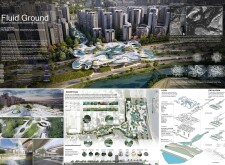5 key facts about this project
## Analytical Report: Fluid Ground - Future of Han River, Future of Seoul City
### Overview
"Fluid Ground" is a design initiative focused on revitalizing the Han River in Seoul, South Korea, with an emphasis on ecological sustainability and urban functionality. The project aims to reconnect the densely populated urban environment with the natural landscape of the river, fostering a harmonious integration that reflects the historical significance of the waterway while accommodating contemporary needs.
### Spatial Strategy
The master plan features a series of multifunctional spaces designed for pedestrian activities, sports, and leisure, organized horizontally to promote fluid movement across the site. A well-defined pedestrian circulation network enhances accessibility and encourages interaction with the wider urban context. Curated observation zones offer engaging viewpoints that invite connections between the river and the urban landscape, while community spaces adhere to universal design principles, ensuring inclusivity for diverse user groups.
### Materiality and Sustainability
The material selection for "Fluid Ground" supports both functionality and aesthetic coherence. Concrete provides structural integrity, while glass elements facilitate visual connectivity to the surrounding environment. Wood is utilized in soft landscaping and park furniture to enhance the natural character of the design. Steel structures offer a modern framework for multi-use platforms. Additionally, incorporating native flora into the landscaping promotes local biodiversity and underscores the project's commitment to ecological stewardship. The design utilizes advanced computational methods to simulate hydrological dynamics, resulting in organic forms that resonate with the river’s flow. The interplay of water features within the landscape creates microclimates that enhance both biodiversity and user engagement.



















































